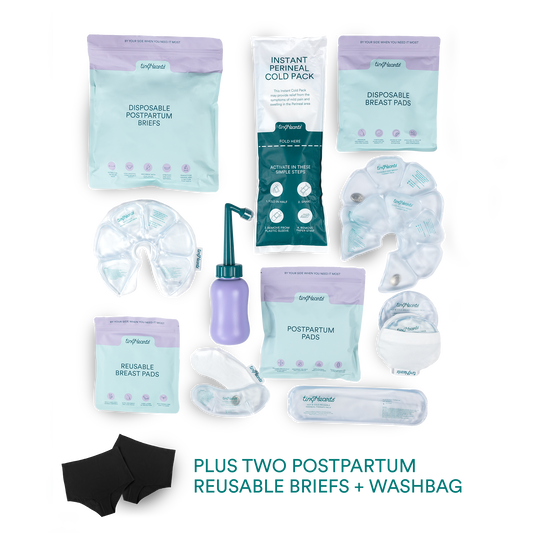If you're concerned about your milk supply, you're not alone. Lots of mamas worry that they have a low milk supply. Happily, for many women, low milk supply is a temporary issue. While there's no magic bullet that will instantly increase your supply, with consistency and a little bit of time, there are things you can do to help boost it. The best way to increase your supply is by effectively removing milk from your breasts. That's because breast milk production works on a classic supply and demand system. The more milk that's removed from your breasts, the more milk your breasts will make.
Let's look at how to increase the amount of milk removed from your breasts to help boost your supply.
Feed Effectively and Often
Start by offering your baby more frequent feeds. Then, check that they're effectively removing milk from your breast when they're feeding. You want to make sure your baby is draining your milk properly, so you're making the most of every feed. Is their latch correct? Is there something going on that's stopping them from draining your breast properly, like a swallowing issue? It could be as simple as changing your breastfeeding position so your baby gets a deeper latch and can take on more milk. A health professional, like a lactation consultant, can help you figure this out.
Use Breast Massage
The next step is to start using breast massage. Gentle massage before a feed or pumping session, such as with a warmed Lactamo breastfeeding ball, will help open up your milk ducts. You can roll a Lactamo over your nipple before a feed to stimulate your hormones and initiate your let-down reflex, and you can use it during a feed to keep encouraging those let-downs and help keep your baby sucking. The more your baby sucks, the more milk they'll remove from your breasts.

Encouraging A Sleepy Baby
What if your baby isn't feeding effectively because they're too sleepy at the breast? You can try switch feeding. Instead of feeding your baby on one side until it's drained, you can switch sides when they become sleepy. Look to offer both sides twice per feed. Switching from one breast to the other may prompt your baby to wake up and feed, and the change in milk flow can encourage them to keep sucking effectively. Switch feeding is usually a short-term strategy until your baby gets a bit bigger and stronger and is better able to stay awake for a feed. Another way to keep your baby alert for a feed is to strip them off. Take off their swaddle or wrap, their clothes and even their nappy before you put them to the breast. This stops them from being too cosy to feed, and it also means they can use their hands and reflexes to work out where they are in the world, which means they're more likely to suck. If they start to drift off in the middle of a feed, try opening their nappy again. Having your baby skin-to-skin at the breast also works wonders for your milk-producing hormones. Try skin-to-skin time in between feeds, too.
Scrap The Feeding Schedule
Are you scheduling or timing feeds? If you're worried about your supply, try ditching the feeding schedule and following your baby's cues. During the day, if your baby doesn't wake after 3 hours, you may want to wake them to feed. And overnight? In the first 6 weeks, I recommend waking your baby every 4 or 5 hours for a feed (if they haven't woken before then).

What About Pumping?
If you're following all these steps, but your baby still isn't taking enough milk, you'll want to pump. You can give your baby a top-up feed of formula, and it will fill them up, but it won't help your supply because your body isn't getting the memo that it needs to make more milk. That's where pumping comes in. Nobody wants their entire day to turn into an endless grind of breastfeeding and pumping, so try this sustainable schedule to increase your supply. Limit your feeds to 20 to 30 minutes and then pump for 5 to 10 minutes after each feed. You won't be tearing your hair out, and your baby won't be exhausted from feeding for hours on end, but you're still maximising what you can do for your supply. Make sure your pump fits well, and you've got it on the right settings. Don't focus on how much milk you get when you pump – it's about stimulation and consistency, not volume. And remember, your supply won't increase in a day or two – it'll take 5 to 7 days before you see a change. If you're an exclusive pumper and want to increase your supply, you could try power pumping. Replace one of your pumping sessions with a session that mimics a cluster feed – 20 minutes on, 10 minutes off, 10 minutes on, 10 minutes off, and 10 minutes on. The more milk you remove and the more stimulation your breasts have, the faster you'll make more milk.

Supplements and Medication to Increase Supply
Do certain foods and supplements increase your milk supply? The feedback is mixed. By all means, put some brewer's yeast in your oats, have oatmeal for breakfast, and have a lactation cookie if you enjoy them. What's more important is to make sure you're eating and drinking enough in general. Over-the-counter herbs like fenugreek and goat's rue are often sold as galactagogues (substances that increase your supply), but some of them can also work in the opposite way. There are also prescription-only medicines that increase prolactin, your milk-making hormone. Talk to a healthcare professional before using a lactation supplement.
How Do I Know If I Need to Increase My Breast Milk Supply?
The good news is that most mamas are able to produce the right amount of milk for their baby or babies, and many mamas who think they have a low milk supply actually may not. But if your baby isn't growing along their growth curve, or they're very sleepy and need to be woken for every single feed, it may be a sign that they're not getting enough milk. Have a look at their nappies. After the first 5 days, most babies usually produce 5 to 6 wet nappies every 24 hours. Some babies might only do one or two poos a day, and some will poo after every feed, but what goes in must come out. If you're worried about your milk supply, talk to your healthcare professional for a proper diagnosis. Get your breastfeeding journey off to the best possible start by preparing for it while you're still pregnant. With its antenatal expressing and breastfeeding modules, Tiny Hearts' online Antenatal Course, is a great place to begin.
ABOUT KATE
Kate Barry is a Registered Nurse and International Board Certified Lactation Consultant (IBCLC). She has more than a decade's experience in hospital and community settings, including 5 years working in the Neonatal Intensive Care Unit (NICU). When she's not helping families to meet their baby- feeding goals, she loves swimming and cooking with her husband and their two daughters.







